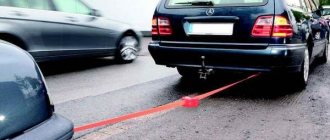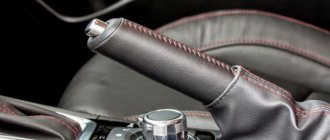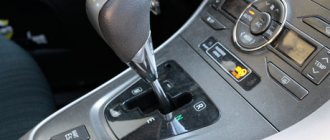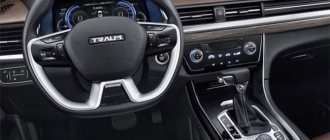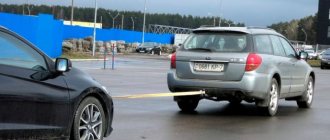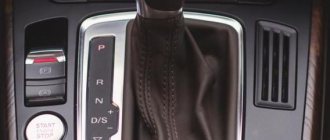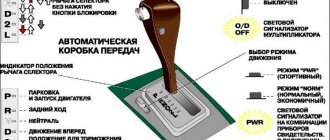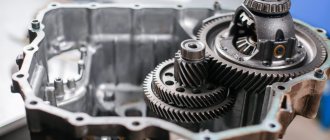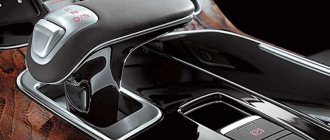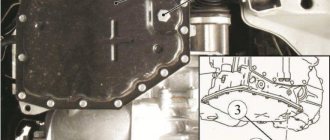Most modern motorists prefer vehicles with automatic transmission, but the level of awareness about the features of their operation is still quite low, in particular, many do not know whether it is possible to tow another car with an automatic transmission. There is no strict prohibition. However, towing cars with an automatic transmission requires taking into account a number of nuances so that the transmission does not fail.
What is the difference between manual transmission and automatic transmission when towing?
When transporting a manual transmission using the towed method, one gear rotates. Moreover, even a switched off engine does not stop the lubrication process.
Towing a car with an automatic transmission is different in that the automatic transmission, when neutral gear is engaged, continues to operate at full power, that is, the entire mechanism is in motion. In this case, the machine inevitably overheats, which ultimately results in a reduction in its service life. The situation is further aggravated by the fact that the oil pump serving the gearbox is correlated with the operation of the internal combustion engine.
Accordingly, towing a vehicle with a switched off internal combustion engine contributes to a catastrophic increase in the risk of machine breakdown, since it will not be provided with oil. Read
Signs, symptoms and consequences of low oil level in automatic transmission
Is it possible to carry a car with an automatic transmission with the engine running?
The transportation process is greatly facilitated when the engine of the towed vehicle is running. With the engine running, the working parts are well lubricated. The battery is charged, the operation of the brake system and power steering does not deteriorate.
Before transporting in a towed vehicle, the gearbox lever is set to neutral and the moving process begins.
Is it possible to tow a car with an automatic transmission?
There is a widespread opinion among car enthusiasts that a vehicle cannot be towed automatically, although few can clearly explain why. Indeed, the design of most types of automatic transmissions is not adapted for operation in this mode, which creates a high risk of failure of various components of the unit due to overloads and overheating. However, if the recommendations are strictly followed, the likelihood of breakdowns will be minimized, and the answer to the question of whether it is possible to tow a car equipped with an automatic transmission will be rather positive.
If the engine is in good condition, then it should be towed with the engine running. First of all, this recommendation is due to the fact that the oil pump functions only when the engine is running, providing lubrication to the machine mechanism. In addition, the power steering and brake systems will operate normally.
The advantage of moving vehicles with the engine running is the elimination of strict restrictions regarding the relocation range established for vehicles with the engine turned off.
Roadside assistance - to take or not to take
And one more question, the answer to which we will give today, is “is it possible to tow another car with an automatic machine”? Anything can happen on the road, and the bonds of automotive brotherhood are strong thanks to a simple principle - if you help, they will help you!
Imagine, it’s night, there’s a highway, you can’t call the towing service, but on the road there’s only you and a car enthusiast who really needs your help, and you have an automatic transmission. Without creating any intrigue, let's say that it is definitely possible to tow another car automatically, however, even in this case, you will need to follow a number of simple rules in order to neutralize the consequences of additional load on your transmission:
A car with automatic transmission as a tractor
Based on the fact that this type of vehicle is often used for transporting trailers, the answer to the question of whether it is possible to tow another with a car with an automatic transmission will be positive.
However, at the same time, the gearbox experiences enormous loads, therefore, in order to avoid premature failure, certain rules should be followed:
- tow an automatic car with another one equipped with an automatic transmission, only using special couplings;
- do not tow a vehicle whose weight exceeds the tractor;
- drive as smoothly as possible;
- do not press the gas pedal all the way;
- stop regularly.
Read
Parking with an automatic transmission: parking modes and proper parking with an automatic transmission for beginners
Following these basic tips will help minimize the likelihood of transmission failure.
Lights when towing
Traffic laws require that the towed (rear) vehicle be clearly visible on the road:
- Hazard warning lights (hazard warning lights) or emergency stop sign. A warning triangle may only be used if the hazard warning lights are faulty. In this case, the sign itself is attached to the rear of the towed vehicle.
- Side lights . When driving at night or in tunnels.
Also, don't forget that in 2022, all moving vehicles must have daytime running lights, low beam headlights, or fog lights on.
That is, both the towing and the towed vehicles must have one of the listed types of lighting devices turned on.
Sequence of actions when towing a car with automatic transmission
Before you start towing a car with an automatic transmission, careful preparation for this process is required in order to prevent possible excesses and minimize the risk of transmission failure. The algorithm of actions is as follows:
- check the transmission fluid level and top it up (if possible), if necessary, to the upper limit to ensure better lubrication and better protection against overheating of components;
- perform a rigid coupling of vehicles with each other (again, these are ideal conditions) to avoid jerks, jolts and other sudden movements. You can pull a car with an automatic transmission using a regular cable only if the engine is running and the steering and braking systems are functioning properly;
- switch the machine to neutral operating mode;
- start the engine of the car that will be towed, if possible, and warm it up to 80-90 degrees.
If you have the owner's manual for a specific vehicle at hand, it is advisable to read it, as it contains a lot of useful information on how to tow your car correctly. In particular, it states at what speed a given car model with automatic transmission can be towed.
Some older automatic transmissions have a special feature that allows you to tow the car. Its purpose is to provide a direct connection between the engine shafts and the automatic transmission mechanism, thereby eliminating the damaged torque converter from the working process. If there is such a function in the gearbox, it should be activated before driving, so that towing a car with an automatic transmission is as safe as possible.
Read
How to correctly check the oil level in an automatic transmission with and without a dipstick
By following basic rules and advice, you can protect the transmission from breakdown and avoid unnecessary expenses.
Bottom line
A car equipped with an automatic gearbox can be towed in desperate situations when it is not possible to use the services of a tow truck. Towing such cars requires the driver to know the features of his car; before starting transportation, you should read the manual for the car and adhere to the manufacturer’s recommendations regarding the distance over which the vehicle can be towed, as well as the speed of its transportation. Violating the restrictions regarding speed and towing distance can lead to overheating of the automatic transmission and its premature failure.
Towing a car with an automatic transmission with the engine not running
The peculiarity of towing a car with an automatic transmission with the engine not running is that in this state the oil supply system does not function, that is, the gearbox mechanisms rotate without lubrication, which is why the degree of wear of parts increases many times over.
To minimize the negative impact of the car being towed with the engine turned off, it is advisable to adhere to a number of rules:
- start towing the vehicle only after switching the automatic transmission to the neutral position;
- ensure rigid coupling of vehicles with each other;
- move as smoothly as possible;
- tow at low engine speeds;
- adhere to the manufacturer's or generally accepted restrictions regarding the speed and range of non-stop movement.
Some modern car manufacturers directly prohibit towing with the engine turned off, so to find out for sure whether it is possible to tow a specific car automatically with the power unit turned off, it is advisable to read the owner's manual.
In what cases is it necessary to tow a car in winter:
- malfunctions as a result of a traffic accident;
- lack of fuel;
- getting caught in snow drifts.
Basic rules for towing in winter:
- The towed vehicle must be equipped with a special hazard warning light.
- If this is not possible (the battery is discharged, the car will not start), a special sign is installed at the rear, notifying about an emergency stop.
- The towing vehicle must weigh more than the vehicle being towed.
- No passengers are allowed in the towed vehicle.
How many kilometers can you tow a car with an automatic transmission?
In the user manual, the manufacturer usually provides information about at what speed and for how long a specific car model with automatic transmission can be towed.
Read
How to drift automatically
In the absence of such data and the impossibility of obtaining it, one should proceed from the following recommendations:
- A vehicle equipped with a three-speed automatic transmission can be towed within 35 km at a speed not exceeding 30 km/h;
- Cars equipped with a gearbox with three or more gears are allowed to be towed for a distance of 50 kilometers, while adhering to a speed limit of 50 km/h.
It is prohibited to exceed the above limits and to pull a vehicle with an automatic transmission with another car over longer distances or faster. If there is more mileage between the start and finish points, then it is important to make stops at specified intervals, giving the rubbing parts the opportunity to cool. In hot weather, it is advisable to increase the break time to one hour.
How to properly tow a car in principle
Focusing on technical issues, car enthusiasts often lose sight of organizational ones. The first step is to look in the trunk for a cable whose carrying capacity exceeds the weight of the car three times. At the same time, it is necessary to eliminate uncertainty in the operation of the brakes and steering by checking the whole thing.
For your information. You cannot tow on a rope in icy conditions. The maximum speed of the exercise is no more than 50 kilometers per hour.
It is necessary to agree in advance on the method of communication:
- blinking "distant";
- normal multiple signal;
- mobile phone switched to speakerphone mode.
- the cable must be bright and have signal flags;
- attach the connecting link diagonally (this ensures shock smoothing, transparent visibility, and the wheel does not hit the rope);
- turn on the ignition so that the steering wheel lock does not operate;
- activate the “thank you” or hang the emergency triangle on the trunk.
The driver should change lanes in advance and turn in a maximum arc, since the trailer always cuts off the trajectory. When driving a faulty car, you need to monitor the tension of the cable: when it sags, brake smoothly.
Consequences of transporting a car with an automatic transmission without following the rules
It is important to adhere to the manufacturer’s advice and practice-developed rules for towing a car with an automatic transmission because otherwise the transmission may be seriously damaged due to overheating and insufficient lubrication. The most common faults are presented in the table below.
| Type of malfunction | Nuances |
| Torque converter module burnout | One of the most serious consequences observed if towing is incorrect, and is expressed in the machine slipping or its complete loss of performance. Replacing this component can cost up to 5% of the total price of the vehicle. |
| Melting of gearbox components | Signs of slipping are similar to those above. Repair involves replacing failed parts. |
| Premature wear of machine elements | It is expressed in the transmission slipping in certain operating modes, primarily when moving forward. To return the transmission to working condition, it is necessary to replace worn parts. Most often you have to change clutches. |
Read
What is the difference and how does a robotic gearbox differ from an automatic gearbox?
Other typical breakdowns that may occur if you tow a car with violations are:
- failure of the oil pump;
- gear failure;
- destruction of soft internal components in the variator box;
- malfunctions of the electronics in the robot box.
Each of these problems requires expensive repairs, which is why it is so important to tow according to the basic rules.
Technical side of the issue
Automatic transmission.
Towing a vehicle with an automatic transmission is permitted, but with some restrictions. You need to tow a car with an automatic transmission in neutral. Even in this position, when the machine moves, rotational movements are performed by the entire gearbox mechanism. The transmission is not designed for this kind of load - this will lead to rapid overheating of the unit, which may even cause its failure. Plus, the oil pump servicing the automatic transmission performs its functions only when the power unit is running. If you drag a car with the engine turned off, the elements of the automatic transmission will work without the supply of lubricant mixture, which can lead to premature failure of the device.
Please note that cars equipped with an automatic transmission and an all-wheel drive system are best transported using a tow truck; this is often indicated by the manufacturer in the vehicle’s operating instructions. The machine must be moved by lifting the front or rear axle; using a hitch for transportation is not advisable.
It is permissible to use a car equipped with an automatic transmission as a tow vehicle if such a possibility is indicated in the vehicle manual. Many automatic transmissions are not designed for the additional loads that arise when using the car as a towing vehicle.
Tips and recommendations from experienced car owners
Experienced drivers advise pouring an extra liter of oil into the transmission before towing a car with an automatic transmission. This will provide additional lubrication of the elements and prevent them from overheating and damage.
If you intend to tow one car with another with rear-wheel drive, according to experts, for ideal conditions, you should disconnect the automatic transmission from the drive wheels, for which experts recommend removing the driveshaft. If this is not possible, the rear axle must be suspended.
Most experts do not recommend towing vehicles with all-wheel drive. The best solution if it is necessary to transport them is to call a tow truck, however, if in the end this kind of possibility is not possible, then one of the bridges must be hung up; a traditional hitch cannot be used.
In general, transportation with an automatic transmission in tow can be quite safe for the transmission if you follow the manufacturer's recommendations and the advice of experienced specialists.
Towing vehicle equipped with an automatic transmission
A car equipped with an automatic transmission as a tug.
How to tow an automatic transmission? When starting transportation, read the manual for the car; it specifies the speed, distance and tonnage with which a car with an automatic transmission can be used as a tug. If it is not possible to read the instructions for the car, follow these recommendations:
- Use a rigid hitch for towing.
- The weight of the towed vehicle must be less than the weight of the vehicle acting as a tow.
- Position D of the automatic transmission selector is unacceptable; manual mode and 2nd or 3rd gear are used. You should not engage in higher gears, as this will create additional loads. At lower speeds, the transmission heats up more slowly.
- The “leading” car must move away slowly and smoothly, move without sudden braking or jerking; any sudden movements can damage the automatic transmission.
Fundamental Rules for Proper Towing
General towing rules provided for by traffic regulations
The article will not talk about all the possible methods that a driver in trouble can use, but only the most accessible and fastest ones, those that can be resorted to without the involvement of additional transport, for example, a specialized tow truck. Naturally, if a person has the opportunity to contact a car towing organization, he has the funds for this, and other towing methods have proven to be simply powerless, there is no point in refusing this kind of help. True, what most often happens is that people try to avoid contacting a road service because they do not have enough money, connections, or are put off by the fact that there are only 200–300 meters left to the garage.
If a stuck driver is at a loss and doesn’t know what needs to be done, the first thing to do is turn to fellow drivers who happen to be passing nearby. Even before towing, you should remember the rules of the road, which state that:
- the towing vehicle must be technically sound and have low beams on while driving;
- the towed car must be equipped with an emergency alarm; if such a procedure takes place in the dark, the side lights in the car should be turned on;
- If transportation is carried out using a flexible hitch, not only the steering device, but also the brakes must function normally in the faulty car. In the case of a rigid coupling, only a working steering device is required.
In addition to these requirements, traffic rules warn about the necessary presence of a high-quality coupling (tie). Naturally, towing any passenger car cannot be done without the help of a standard towing device - a cable, which will allow you to quickly “pull” a stuck car. A tow rope should be purchased in advance and carried “just in case” in the luggage compartment. Moreover, it is better to refuse to buy cheap options offered by unknown manufacturers. It is no secret that when towing a vehicle, unexpected jerks often occur, causing the cable to break, which can burst from excessive load. A broken cable will “help” an already dejected driver, causing a lot of trouble; the worst outcome could be an accident caused by the driver of the towed vehicle. According to the stipulated standards, the length of the tow rope should be 6 meters.
The fact is that recently fewer and fewer people are trying to follow the rules and act in accordance with driving etiquette. Such actions are not only not welcome on the road, where understanding and mutual assistance should reign, but can also bring a lot of trouble to a hasty driver. What does a person do when he sees a car in front of him with his emergency lights on? The practical majority of car owners try to quickly overtake a slow-moving car; it is while making a decision to overtake such a car that one can unexpectedly come across an invisible, or rather, hidden in the darkness (if the movement occurs in the dark), cable. The driver of a towed vehicle must drive with utmost attention; if he sees the intention of a neighboring car owner to wedge himself between his car and the tow, he must immediately warn such a motorist with loud sounds of the horn. If these do not help, then you can resort to not quite decent gestures that will more clearly warn of the danger.
